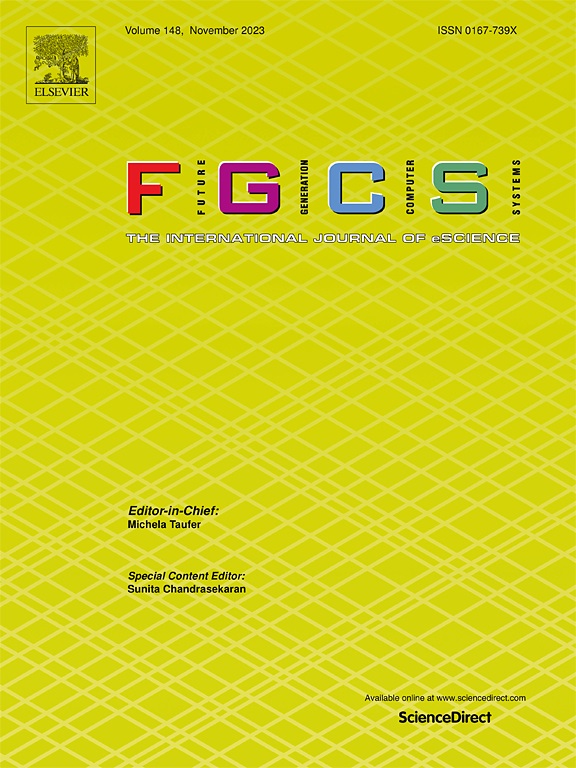Bridging paradigms: Designing for HPC-Quantum convergence
IF 6.2
2区 计算机科学
Q1 COMPUTER SCIENCE, THEORY & METHODS
Future Generation Computer Systems-The International Journal of Escience
Pub Date : 2025-06-28
DOI:10.1016/j.future.2025.107980
引用次数: 0
Abstract
This paper presents a comprehensive software stack architecture for integrating quantum computing (QC) capabilities with High-Performance Computing (HPC) environments. While quantum computers show promise as specialized accelerators for scientific computing, their effective integration with classical HPC systems presents significant technical challenges. We propose a hardware-agnostic software framework that supports both current noisy intermediate-scale quantum devices and future fault-tolerant quantum computers, while maintaining compatibility with existing HPC workflows. The architecture includes a quantum gateway interface, standardized APIs for resource management, and robust scheduling mechanisms to handle both simultaneous and interleaved quantum–classical workloads. Key innovations include: (1) a unified resource management system that efficiently coordinates quantum and classical resources, (2) a flexible quantum programming interface that abstracts hardware-specific details, (3) A Quantum Platform Manager API that simplifies the integration of various quantum hardware systems, and (4) a comprehensive tool chain for quantum circuit optimization and execution. We demonstrate our architecture through implementation of quantum–classical algorithms, including the variational quantum linear solver, showcasing the framework’s ability to handle complex hybrid workflows while maximizing resource utilization. This work provides a foundational blueprint for integrating QC capabilities into existing HPC infrastructures, addressing critical challenges in resource management, job scheduling, and efficient data movement between classical and quantum resources.
桥接范例:hpc -量子收敛设计
本文提出了一种集成量子计算(QC)能力和高性能计算(HPC)环境的综合软件堆栈体系结构。虽然量子计算机有望成为科学计算的专用加速器,但它们与经典HPC系统的有效集成提出了重大的技术挑战。我们提出了一个硬件无关的软件框架,该框架支持当前嘈杂的中等规模量子设备和未来的容错量子计算机,同时保持与现有HPC工作流程的兼容性。该架构包括一个量子网关接口,用于资源管理的标准化api,以及处理同时和交错的量子经典工作负载的健壮调度机制。关键创新包括:(1)有效协调量子和经典资源的统一资源管理系统;(2)抽象硬件特定细节的灵活量子编程接口;(3)简化各种量子硬件系统集成的量子平台管理器API;(4)用于量子电路优化和执行的综合工具链。我们通过实现量子经典算法(包括变分量子线性求解器)展示了我们的架构,展示了框架在最大限度地利用资源的同时处理复杂混合工作流的能力。这项工作为将QC功能集成到现有HPC基础设施中提供了基础蓝图,解决了资源管理、作业调度以及经典资源和量子资源之间高效数据移动方面的关键挑战。
本文章由计算机程序翻译,如有差异,请以英文原文为准。
求助全文
约1分钟内获得全文
求助全文
来源期刊
CiteScore
19.90
自引率
2.70%
发文量
376
审稿时长
10.6 months
期刊介绍:
Computing infrastructures and systems are constantly evolving, resulting in increasingly complex and collaborative scientific applications. To cope with these advancements, there is a growing need for collaborative tools that can effectively map, control, and execute these applications.
Furthermore, with the explosion of Big Data, there is a requirement for innovative methods and infrastructures to collect, analyze, and derive meaningful insights from the vast amount of data generated. This necessitates the integration of computational and storage capabilities, databases, sensors, and human collaboration.
Future Generation Computer Systems aims to pioneer advancements in distributed systems, collaborative environments, high-performance computing, and Big Data analytics. It strives to stay at the forefront of developments in grids, clouds, and the Internet of Things (IoT) to effectively address the challenges posed by these wide-area, fully distributed sensing and computing systems.

 求助内容:
求助内容: 应助结果提醒方式:
应助结果提醒方式:


